W9: Cerebellum and Motor Learning
1/27
There's no tags or description
Looks like no tags are added yet.
Name | Mastery | Learn | Test | Matching | Spaced |
|---|
No study sessions yet.
28 Terms
Learning Objectives
anatomy of cerebellum + divisions
the principal input and output pathways
the organisation of the cerebellar cortex
the parallel-fibre / Purkinje model of learning
roles of the cerebellum in motor control
the ability of the cerebellum to predict
hierarchical sensory-motor organisation
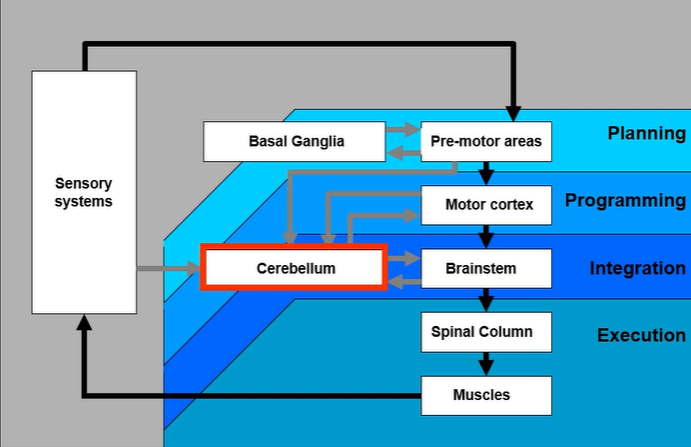
Cerebellum - little brain
massive cortical area = much simpler than cerebral cortex (only 1 output layer)
heavily folded
exerts influence on movement via influence on motor + pre-motor cortex
also connects with brainstem + spinal cord
adds:
coordination
fine control
skill
^ to basic movement patterns
a powerful learning machine
Flattening the cortical sheet
length of cerebellar cortex reflects body mass
width may reflect cognitive properties
e.g. cow is larger so cerebellum is longer, but it is narrower bc humans perform more cognitive functions than cows
Human Cerebellum: cell numbers
total = 102 billion
granule cells
purkinje cells
golgi, basket, stellate
nuclear cells
purkinje cell inputs:
from parallel fibres
from climbing fibres
cerebellum is smaller than cerebral cortex = but has more cells
layers in cerebellum pic

cerebellar cortical connections
purkinje cells = place where motor learning takes place
shows that sensory info is coming from different sensory parts of cortex
arriving through mossy fibres
cerebellum can predict using sensory info
e.g. you need to catch a ball - cerebellum uses sensory info (visual) to know where you need to be in space (from climbing fibre)
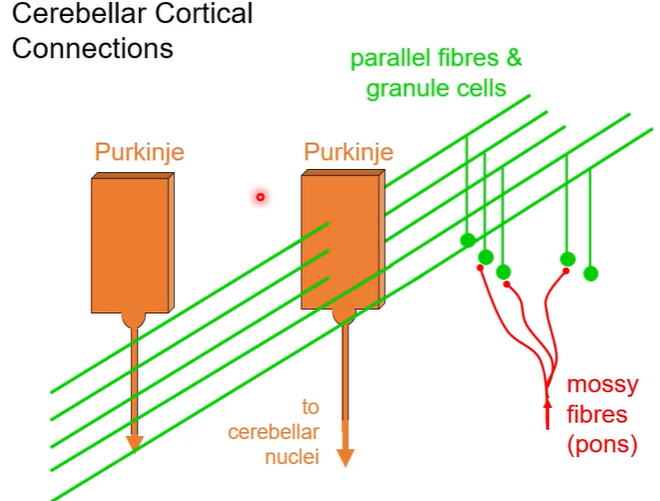
cerebellum circuit
this circuitry allows the cerebellum to:
refine movement
detect errors
facilitate motor learning
through precise modulation of output signals
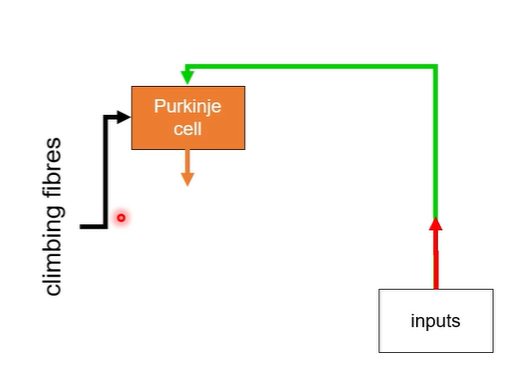
Deep Cerebellar Nuclei
output from the cerebellum to the rest of the brain = through deep cerebellar nuclei
they send outputs to the motor structures of the cerebellar cortex
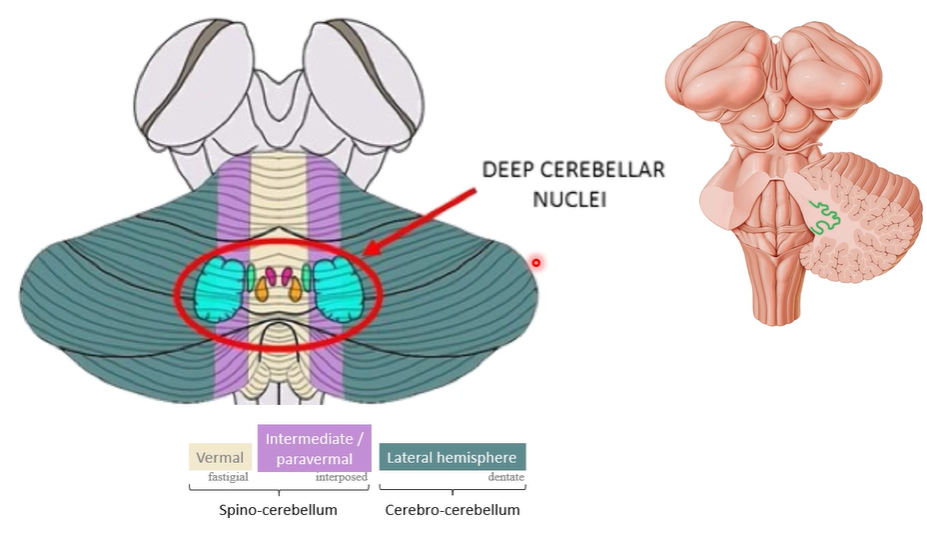
Inputs: circuit pic
info about the motor action you want to perform would arrive at the purkinje cells
output from purkinje to nuclei = inhibitory = reduces activity of cerebellar nuclei

Cortex-Cerebellar Loops
MRI studies
can see what parts of the cerebellum are active when receiving info from different areas (e.g. visual cortex, auditory, somatosensory)
Cerebellar Damage
Hypermetria (overshoot) = finger-to-nose
Intention tremor = esp during action
Ataxia = loss of coordination + skill
Nystagmus, balance, gait, speech
Cerebellar affective disorder = executive, emotional, personality (children are affected this way)
Cerebellum + Motor Learning: Marr-Albus model of learning
The synapse between granule cells (parallel fibres) + Purkinje cells = is plastic = can undergo Long Term Depression (LTD)
The trigger for LTD is simultaneous activity of parallel fibres
climbing fibres (associative learning) via mossy fibres
error signal via climbing fibres
LTD reduces P-cell inhibition of cerebellar nuclei + dis-inhibits the direct pathway
= cerebellar nuclei more active
LTD = connection gets weaker over time w certain activity
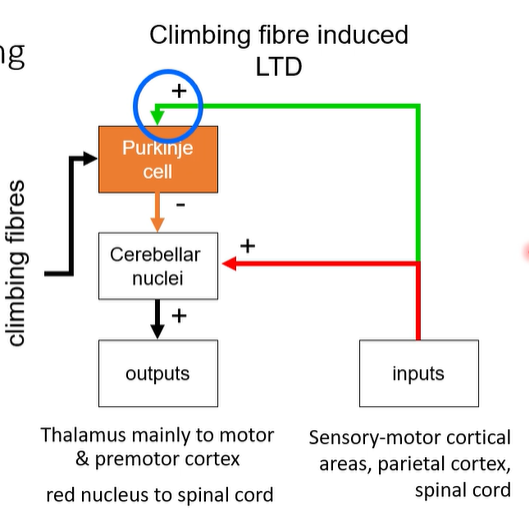
4 examples of cerebellar learning
Vestibular Ocular Reflex (VOR)
Eye Blink conditions
Skill Learning
Visuo-motor recalibrating
Vestibular Ocular Reflex (VOR)
VOR is a mechanism that helps stabilise vision during head movement
does this by producing eye movements that counteract head motion
makes sure image on retina is stationary
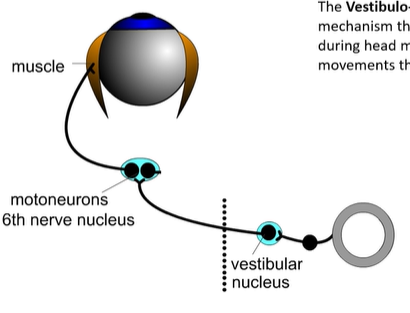
VOR gain
Input: vestibular system signal of head motion
Output: modulation of direct path to ocular motor neurons
Consider: VOR gain too weak
retinal slip drives LTD
reduced excitation of P-cell
dis-inhibition of vestibular nucleus = stronger drive = higher gain
Training signal: retinal slip signal on climbing fibres

Eye Blink conditioning
Classical conditioning: lesion of cerebellum = failure to learn
Unconditioned stimulus: puff of air into eye (also activates climbing fibres)
Unconditioned response: eyeblink
Conditioned stimulus: a tone/light (activates parallel fibres)
Conditioned response: learned eyeblink to avoid air puff
explained:
the cerebellum helps link the CS (tone) with US (air puff) using LTD at parallel fibre - Purkinje cell synapse
this weakens Purkinje cell inhibition = cerebellar nuclei generates a times blink in response to tone
if the cerebellum is lesion = this learning doesnt happen
Eye Blink CC
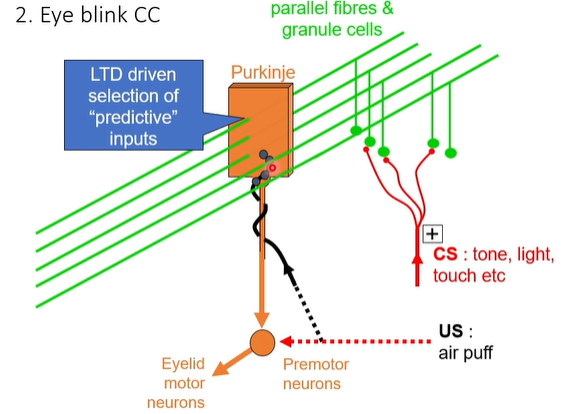
Skill Learning
monkey in a lab grasping device that animal could twist
animals task was to stabilise the weights
recoding directly from Purkinje cells in cerebellum - animal cant feel bc brain doesn’t have any pain receptors
first time being able to see learning take place in real time - activity of Purkinje cells
first bump = action, underneath = action potentials
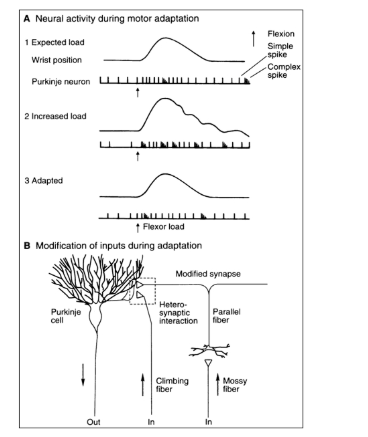
Visuo-motor recalibration
prism glasses distort visual inputs - need to adjust movement output to recalibrate
imagine you reach out for object below
with prism glasses you see your hand moving upwards
if you reach out to 12:00 and hit 4:00, you know you need to reach 8:00 to get to 12:00 = recalibrating the motor system
short term learning of visuo-motor relationship
learning blocked by cerebellar lesions
Summary
Cerebellar cortex = big
important for all skilful movement
huge numbers of parallel fibres bring very diverse sensory-motor input to Purkinje cells
climbing fibres induce parallel fibre = P-cell LTD
adjusts VOR gain - support classical conditioning of eye-blink
predictive control
Normal throwing
need to throw a ball at target
a signal activates muscles = move limbs to throw
a copy of the motor command that goes to the body also goes to the cerebellum (so it knows what we about to do) = efference copy
when the ball hits target - sensory input goes to cerebellum = it can compare predicted vs actual movements
if there’s a match = no learning needs to take place
if you miss = mismatch = error signal which drives cerebellum to update motor command = changes next movements = compensates so next time get closer to target
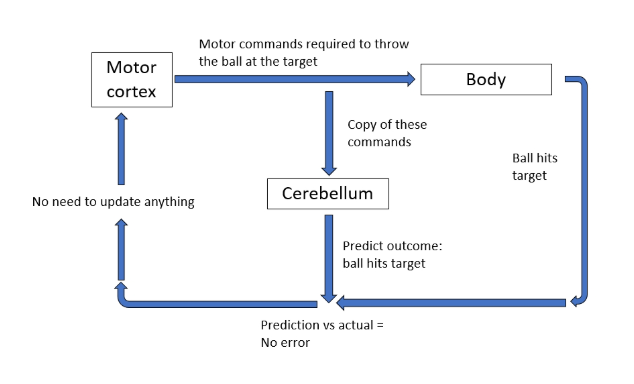
The role of the cerebellum in prediction - study
if you have damage to cerebellum = you shouldn’t be able to see mismatch + learn from mistakes
patients performed visual motor rotation - e.g. controlling cursor and place at specific point on screen
researchers slightly changed it so forward = moves slightly to the side etc
patients struggle to adapt their movements to hit the target
also tried where they move their hand slightly so they have to use more force = but still couldn’t move hand with more force in opposite direction
The role of the cerebellum in prediction
cerebellar patients show impairments in both force-field + visuomotor adaptation
impairments are related to specific degradation of cerebellar areas
force-field = anterior lobe of cerebellum
visuomotor = posterior lobe of cerebellum
SO - the cerebellum appears to perform the same function (prediction) across tasks with each being related to specific regions

Study: motor prediction
ppts had to move hand to a target (sweeping motion with hand)
they created a virtual lesion by exciting brain with a magnetic pulse = temporarily disrupted the function of the cerebellum
showed that the cerebellum is also involved in a process called ‘state estimation’ = estimating where the limb is throughout the entire range of movement
another study:
had to reach target + some got a sensation in limb as reward
some did without
found - cerebellum still predicts movement irrespective of any sensory input
The importance of prediction: Ronald vs Ronaldo
the ability to predict the sensory outcomes of your motor commands
fast responses as you do not need to ‘wait’ for slow sensory feedback to update your behaviour (basc the ability to correct errors fast)
performing actions when sensory feedback is not available / poor quality (e.g. in darkness)
ability to predict upcoming actions based on the outcomes of the current one (increase planning horizon)
the ability is associated with highly skilled behaviour - athletes show greater cerebellar grey matter volume
Study: cerebellum disrupting language prediction
TMS study - disrupted functioning of cerebellum during language task
= impaired ability for students
impaired ability to generate an appropriate verb in response to a noun = was a delay in generating the verb
e.g. banana (choose from eat, car, drive etc)
Summary
the cerebellum is essential for prediction within the motor system - enables the performance of fast + accurate movements
this ability is key for skilled performance (athletes + musicians) - appears to develop across childhood
this ability is severely impaired in patients with cerebellar disease (apraxia)
the cerebellum has reciprocal connections to all areas of the cortex - it is hypothesised that the cerebellum plays a similar role in prediction across domains
language, working memory, arithmetic
non-invasive brain stimulation (tdcs) of the cerebellum can enhance our ability to predict but results are difficult to replicate